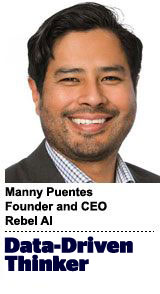 “Data-Driven Thinking” is written by members of the media community and contains fresh ideas on the digital revolution in media.
“Data-Driven Thinking” is written by members of the media community and contains fresh ideas on the digital revolution in media.
Today’s column is written by Manny Puentes, founder and CEO at Rebel AI.
As innovative as the invention of the automobile was on its own, cars didn’t become commonplace until the assembly line and nationwide gas stations made it easier for everyone to own one.
In the same way, blockchain won’t transform the advertising industry and bring its promised transparency until the necessary organization and infrastructure is in place to support it.
Though a handful of startups and some larger companies are at work building the first advertising applications of blockchain, it’s going to take a collective effort on the part of all players in advertising to make this technology work in the real world.
I see three steps that must happen before blockchain becomes a reality in advertising.
1. Agree To A Common Currency
Some mistakenly think blockchain’s decentralization will result in greater pricing efficiency, but in truth, that decentralization comes at an actual price: paying the miners who maintain the decentralized execution of verifying each transaction and recording the resulting “blocks.”
The compute power those miners consume costs real money, and the advertising industry will have to establish an accepted currency to pay miners and maintain true decentralization.
While coins such as BAT and ADT aim to be that currency within their own platforms – Brave and MetaX, respectively – the wider industry will have to identify the ideal currency for transacting advertising. Ideally, the IAB or a similar nonprofit trade organization would create its own currency to avoid favoring any one company over others.
There is also the potential that the right solution for advertising will be a currency-free distributed ledger rather than a traditional blockchain. These alternatives, known as directed acyclic graphs (DAGs) don’t rely on compute-heavy miners to verify transactions, but instead rely on users of the system to confirm previous transactions.
IOTA, one of the best-known DAGs specializing in internet-of-things development, requires that every device that sends a transaction to also confirm at least two previous transactions that occurred somewhere within the network.

IOTA’s Tangle algorithm requires each transaction to verify two other transactions. Green boxes here represent a transaction that has been sufficiently verified and confirmed, while red boxes represent newer transactions that have not yet been sufficiently verified. (Navinram/CC 4.0)
This promises that transactions will become faster and more scalable with every device that comes online. A solution like this might not just solve the blockchain currency question, but also advertising’s real-time speed requirements.
2. Establish Smart Contract Standar
Just like the IAB stepped in to standardize real-time bidding with the OpenRTB Spec in the late 2000s, the organization will need to establish a global standard for communicating via blockchain contracts so that different businesses can easily plug into the blockchain ecosystem.
Startups today each have their own version of wallets and blockchain interfaces, but as more companies enter the ecosystem, integrations will quickly become unwieldy and require too much customization.
Today’s popular blockchain platforms were written to serve the financial industry and don’t yet have the capabilities to pass the information needed to transact advertising. The IAB’s new Blockchain Working Group will need to first identify the metadata required to transact media, then work to build an initial standard contract template so that technology providers, advertisers and publishers can all communicate and transact in a standardized way.
3. Tackle The Meaning of ‘Transparency’
Though blockchain does offer unprecedented levels of transparency, the industry must also establish what it actually wants to expose on the auditable ledgers.
Blockchain in its basic form is inherently public, so it’s going to take layered technologies to protect identity and other sensitive information. Stakeholders need to define exactly what metrics and data should be transparent and auditable and what data should be more securely protected and private.
While many in advertising are working to understand exactly how blockchain technology works, it’s even more important to understand how the technology will be applied. We need to have concrete conversations now so we can make collective decisions as early as possible. The IAB Working Group is a great start in this direction, and every advertising company should feel empowered to contribute to the conversation that will shape the industry.
In the end, blockchain is simply another technology layer to help the industry collectively reach its long-promised potential: transacting media in a way that is transparent, fair and fraud-free.
Follow Manny Puentes (@epuentes), Rebel AI (@Rebel_AI_) and AdExchanger (@adexchanger) on Twitter.
This post was syndicated from Ad Exchanger.

More Stories
The IAB Predicts Social Video Will Overtake CTV This Year
Best Buy and CNET Are Combining Their Ad Inventory
Buyers Are Wasting Money on Alt IDs While Cookies Still Persist